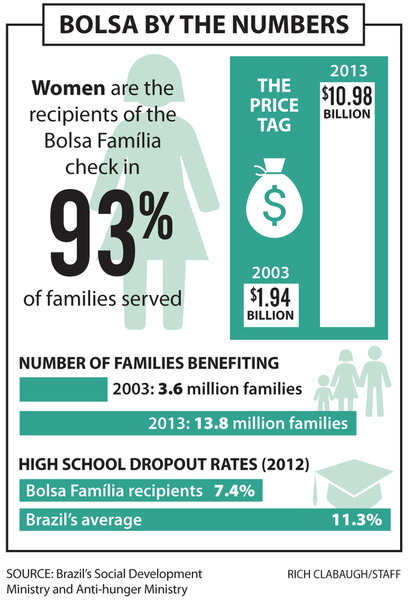Big change for a buck? Latin America says 'yes'
Loading...
| Rio de Janeiro
Here's a dollar – if you change your behavior.
That's the revolutionary – and controversial – idea behind conditional cash transfer programs for the poor, which cover 129 million people across 18 Latin American countries, nearly a quarter of the entire region's population.
The largest such program is Brazil's Bolsa Família, which gives a small monthly stipend to 13.8 million families. Mothers must receive pre- and postnatal care, and children must receive basic vaccinations and stay in school until age 17. The Ministry of Social Development monitors feedback from doctors and schools, and the stipend is then deposited into the recipient's bank account (preferably that of a woman).
Rômulo Paes de Sousa, Brazil's former vice minister of social development, who designed many of Bolsa Família's monitoring programs, calls it a "contract" between the government and family, with similar versions across Latin America.
Honduras's Bono 10,000 program, for example, provides payments twice a year instead of monthly. Mexico's Oportunidades plan requires twice-yearly health checkups for all household members, not just mothers and infants.
"There is a set of commitments by the recipient, but no conditions on how the money is spent," Mr. Paes says.
Critics say such programs are either too overbearing or, conversely, not demanding enough. For instance, why doesn't the state also stipulate that the money not be spent on tobacco or alcohol? How does the state know it's better for a child to be in a potentially dysfunctional school than working? And is it ethical to offer a starving family food with strings attached?
The results show the answer, says Paes, who now directs the United Nations World Centre for Sustainable Development in Rio de Janeiro. Among many studies, in 2010 the International Food Policy Research Institute found Bolsa Família families receive 1-1/2 times as many prenatal checkups, their children are more likely to receive vaccinations on schedule, and their overall school attendance rises by 4.4 percentage points.
The program also increases by 19 percentage points the likelihood that a 15-year-old girl – among those most at risk for dropping out – will remain in school.
"The program has worked," Paes says.








